|
|
|
Sort Order |
|
|
|
Items / Page
|
|
|
|
|
|
|
| Srl | Item |
| 1 |
ID:
132541
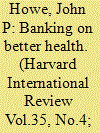

|
|
|
|
|
| Publication |
2014.
|
| Summary/Abstract |
HIV is no longer a death sentence" - that hopeful declaration-which would have been unthinkable even a decade ago- has now become a cliché by repetition whenever experts, physicians, academics and journalists gather to chart progress in fighting the disease and to set goals for the future. But for many people, sadly, that statement is not actually true. There remains no cure for the disease, and not everyone can get access to the anti-retrovirals (ARVs) that have done so much to help so many. This reflects the painful truth that poverty remains a major impediment to good health in the developing and even the developed world.
|
|
|
|
|
|
|
|
|
|
|
|
|
|
|
|
| 2 |
ID:
086135


|
|
|
|
|
| Publication |
2009.
|
| Summary/Abstract |
The recent proliferation of regional trade agreements in the East Asian region can be seen as the most notable development in the region's trading panorama in recent years. Yet, very little is as yet understood about the anatomy of these agreements and, consequently, their full implications to the regional economy. This article strives to fill this gap by analyzing the structure of four dozen RTAs by their various key component parts, including tariff liberalization schedules, rules of origin, and competition policy, customs, investment, and services provisions. The results reveal that intra-Asian RTAs are generally quite rapidly liberalizing, with the exception of agriculture, but they are also quite thin in trade-related disciplines when compared with the more legalistic US trans-Pacific RTAs and those of Mexico and Chile. The proposed Free Trade Area of the Asia-Pacific would inherently be a construct of the political economy interests of these various constituent RTAs.
|
|
|
|
|
|
|
|
|
|
|
|
|
|
|
|
| 3 |
ID:
132678
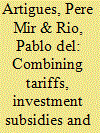

|
|
|
|
|
| Publication |
2014.
|
| Summary/Abstract |
Policy combinations and interactions have received a considerable attention in the climate and energy policy realm. However, virtually no attention has been paid to the analysis of the combination of different deployment instruments for the same renewable energy technology. This neglect is all the more striking given the existence in current policy practice of combinations of deployment instruments either across technologies or for the same technology, both in the EU and elsewhere. What renewable electricity support policies to use and, therefore, how to combine them in order to promote the deployment of renewable energy technologies cost-effectively is a main concern of governments. The aim of this paper is to provide insight on the cost-effectiveness of combinations of deployment instruments for the same technology. A financial model is developed for this purpose, whereby feed-in tariffs (FITs) are combined with investment subsidies and soft loans. The results show that the policy costs of combinations are the same as for the FITs-only option. Therefore, combining deployment instruments is not a cost-containment strategy. However, combinations may lead to different inter-temporal distributions of the same amount of policy costs and, thus, differently affect the social acceptability and political feasibility of renewable energy support.
|
|
|
|
|
|
|
|
|
|
|
|
|
|
|
|
| 4 |
ID:
171975
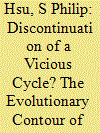

|
|
|
|
|
| Summary/Abstract |
As a retrospective exploration of China’s central–local relations over the past four decades of the reform era, this paper argues that since the mid-1990s, relations have evolved with a growing likelihood to break away from the vicious cycle of decentralization and recentralization since 1949. China’s post-reform era started in synchronization with a sweeping move toward decentralization, a trend which generated a myriad of systemic crises that threatened the legitimacy and survival of the regime. Thus, the mid-1990s saw a systematic rollback of decentralization. This rollback is to be understood as a comprehensive scheme of rebalancing rather than a mere replication of pre-reform recentralization. On the other hand, the rebalancing has still occurred in consistence with a cyclical pattern that had characterized the broadly conceived regularity of decentralization and recentralization. While the rebalancing has not been immune from various pathologies, the central state has selected to make contingent and marginal adaptations to cope with the problems instead of shattering the current framework of rebalancing and returning completely to decentralization. Instead of relying solely on original research, this paper will bolster its main argument by conducting a synthetic reasoning from a rich array of extant analyses to sketch out the contours of China’s central–local relations in fiscal, investment, and personnel management policy areas during the past four decades.
|
|
|
|
|
|
|
|
|
|
|
|
|
|
|
|
| 5 |
ID:
162650
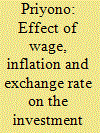

|
|
|
|
|
| Summary/Abstract |
The purpose of this study is to know and analyze the effect of wage variables on regional investment policy, the influence of inflation variables on regional investment policy, and the influence of exchange rate variables on investment policy of the Region on Labor. In this study, the population taken is the entire workforce whose data comes from the Central Bureau of Statistics in Sidoarjo which amounted to 64,792 workers. Data analysis using multiple linear regressions with the help of SPSS program version 20 showed that there is an influence of wages, inflation, and exchange rate on local investment policy. Based on the results of calculations and test results conducted, it can be explained that there is an effect of wages on regional investment of labor followed by the characteristics of inflation on labor that affects the exchange rate of investment. This illustrates for policymakers which empirical evidence exists in a series of time to test the theoretical basis while establishing fiscal, monetary, or exchange rate policies to stabilize output and employment by using interest rates, money supply, and exchange rates as instruments for achieving goals.
|
|
|
|
|
|
|
|
|
|
|
|
|
|
|
|
| 6 |
ID:
098938
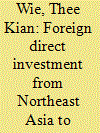

|
|
|
| 7 |
ID:
127161


|
|
|
|
|
| Publication |
2014.
|
| Summary/Abstract |
This work compares the return on investments (ROI) of oil versus biofuels in Brazil. Although several renewable energy sources might displace oil, the country's forte is sugarcane biofuels. In our analysis we carry out simplified benefit-cost analyses of producing oil fields, pre-salt oil fields (without and with enhanced oil recovery), a business as the usual ethanol scenario, and a high ethanol scenario. Excluding the ROI from existing oil fields, which is the highest, when the discount rate is 4% or more, the ROI of the high ethanol scenario is greater than that of the ROI of pre-salt oil. Considering a US$40/t CO2 tax, the high ethanol scenario's ROI is greater than the pre-salt oil's ROI if a discount rate of 2% or more is adopted. Moreover, the high ethanol scenario throughput up to 2070 compares to 97% of the pre-salt oil reserve without EOR, and demands 78% of its investment. Pre-salt oil production declines beyond 2042 when the country might become a net oil importer. In contrast, ethanol production reaches 2.1 million boe per day, and another 0.9 million boe of fossil demand is displaced through bioelectricity, yielding a total of 3 million boe (62% of the country's oil demand).
|
|
|
|
|
|
|
|
|
|
|
|
|
|
|
|
| 8 |
ID:
124885
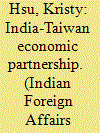

|
|
|
|
|
| Publication |
2013.
|
| Summary/Abstract |
Taiwan, a dynamic democracy and home to the world's leading ICT technology and manufacturing base, is now looking beyond its traditional trading partners and investment destinations, namely China and Southeast Asian countries, towards India as one of its most strategically important economic partner in its revised "Go South" policy for the next decades. As suggested by the new term of IT -- I stands for India and T stands for Taiwan, growing business interests in Taiwan, starting with ICT industry and expanding to other sectors, have driven considerable Taiwanese business delegations visiting India exploring emerging trade and investment opportunities
|
|
|
|
|
|
|
|
|
|
|
|
|
|
|
|
| 9 |
ID:
127241
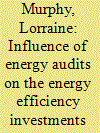

|
|
|
|
|
| Publication |
2014.
|
| Summary/Abstract |
Energy audits are promoted as an effective tool to drive investment in energy efficiency measures in the residential sector. Despite operating in many countries for several decades details of the impact of audits are mixed. The aim of research presented here is to explore the role of audits on investment in energy efficiency measures by private owner-occupied householders in the Netherlands. Results showed that the main influence of the energy audit was to confirm information held by householders. A significant portion of audit recommendations was ignored, the main reason being that householders considered their dwellings to be adequately energy efficient. A comparison of audit recipients to non-recipients showed that audit recipients did not adopt, plan to adopt or invest in more energy efficiency measures than non-recipients. In fact non-recipients adopted more and invested more in measures. It is concluded that energy based renovation is driven by householder perception of comfort and acceptable outlay on energy bills and not necessarily to expert technical tailored information on the potential to reduce CO2 emissions and environmental impact. Results support arguments for minimum energy efficiency standards and performance based incentives.
|
|
|
|
|
|
|
|
|
|
|
|
|
|
|
|
| 10 |
ID:
132517
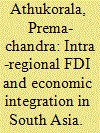

|
|
|
|
|
| Publication |
2014.
|
| Summary/Abstract |
This article examines trends and patterns of intra-regional foreign direct investment (FDI) in South Asia, with a focus on the potential for integrating production processes among countries in the region through further trade and investment policy reforms. The empirical evidence pieced together from scattered sources suggests that horizontal (market seeking) FDI has continued to dominate South Asian intra-regional FDI, with a significant shift in recent years in favour of services sector activities. Vertical (efficiency seeking) FDI in the region has remained confined to a few product lines, predominately garments, and also a few industries in which the availability of specific natural resources plays an important role in the site selection decisions of firms. In other industries, including electronics and electrical goods in which global production sharing is heavily concentrated, there is no evidence of notable cross-border operations by regional firms.
|
|
|
|
|
|
|
|
|
|
|
|
|
|
|
|
| 11 |
ID:
132686
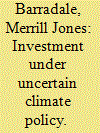

|
|
|
|
|
| Publication |
2014.
|
| Summary/Abstract |
This paper introduces the concept of payment probability as an important component of carbon risk (the financial risk associated with CO2 emissions under uncertain climate policy). In modeling power plant investment decisions, most existing literature uses the expected carbon price (e.g., the price of traded permits or carbon tax) as a proxy for carbon risk. In contrast, this paper identifies expected carbon payment as a more accurate measure of carbon risk as perceived by industry practitioners. This measure of carbon risk incorporates both expected price and the probability that this price would actually be faced in the case of a particular investment. This concept helps explain both the surge of activity in 2005-2006 and the subsequent decline in interest in coal-fired power plant development in the U.S. The data for this case study comes from an extensive online survey of 700 U.S. energy professionals completed in 2006, as well as interviews conducted with industry representatives from 2007 to 2009. By analyzing industry views on policy uncertainty and future carbon legislation, we gain a better understanding of investor attitudes toward carbon risk. This understanding will help policy makers design better incentives for investing in low-carbon technologies.
|
|
|
|
|
|
|
|
|
|
|
|
|
|
|
|
| 12 |
ID:
124927
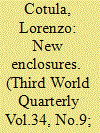

|
|
|
|
|
| Publication |
2013.
|
| Summary/Abstract |
Seven decades after its first publication, Karl Polanyi's The Great Transformation remains one of the most insightful readings about the socioeconomic changes associated with the Industrial Revolution, and the ways in which law facilitated, or countered, moves towards the commodification of land at that time. As today's global land rush brings competing land claims into contest, new transitions are occurring between more commodified and more 'socially embedded' conceptualisations of land. Using Polanyi's framework, this article analyses the role of international law in these processes. International investment law construes land as a commercial asset, can facilitate access to land for foreign investors and imposes discipline on the exercise of regulatory powers in land matters. But shifts in the political economy that underpins international investment law and growing recourse to international human rights law are creating new opportunities for reflecting the non-commercial (cultural, social, political) relations within which land rights remain embedded in many societies. When contrasting conceptualisations of land collide, the relative strength of legal rights and enforcement mechanisms become particularly important. Ultimately, the legitimacy of international law to mediate between competing land claims will depend on the extent to which it can recognise the multiple values that society attaches to land.
|
|
|
|
|
|
|
|
|
|
|
|
|
|
|
|
| 13 |
ID:
132689


|
|
|
|
|
| Publication |
2014.
|
| Summary/Abstract |
Photovoltaic (PV) has developed to one of the most promising technologies for renewable electricity generation. The Austrian government currently provides subsidies for roof-top PV systems through a constant, administratively determined feed-in tariff or an investment co-funding. In both subsidy schemes, applications are approved on a first-come, first-served basis. There are concerns about (i) the selection of suitable roofs for PV systems, and (ii) allocating subsidies among applicants to deploy roof-top PV systems cost-effectively. Thus we analyze the potentials of a simple discriminative first-price reverse auction application scheme. Applicants define individually the required level of subsidy and those with the lowest request for subsidies are selected. In an ex-post analysis, we evaluate the potentials of such a scheme in increasing power output and saving public spending for the federal state of Vorarlberg in Austria. Results indicate a potential increase of cumulated produced electricity between 15% and 18% in comparison to the current policy. In addition, a reverse auction-based system would lead to savings of public spending per kWh between 20% and 41%.
|
|
|
|
|
|
|
|
|
|
|
|
|
|
|
|
| 14 |
ID:
127162
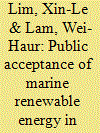

|
|
|
|
|
| Publication |
2014.
|
| Summary/Abstract |
Research and development (R&D) on marine renewable energy (MRE) in Malaysia is still in its initial stage. It is crucial to know the level of acceptance of MRE among Malaysians in order to push the technology forward. A survey was conducted to investigate public acceptance of MRE in SS2, Petaling Jaya. In addition, a face-to-face interview was conducted to understand the concerns of an investor about investing in renewable energy (RE) projects. The results of analysis showed that 82.8% of the respondents support MRE implementation in Malaysia. However, 56.8% of the respondents are reluctant to pay for green electricity. The reason is directly linked to the NIMBYist (NIMBY= Not in My Backyard) attitudes of Malaysian citizens. They are unwilling to support green energy by involving themselves, participating or paying money. Furthermore, the interviewee, on behalf of investors, expressed some opinions on concerns about investment in RE projects. Several ministries and departments are suggested as being important in MRE development.
|
|
|
|
|
|
|
|
|
|
|
|
|
|
|
|
| 15 |
ID:
133848
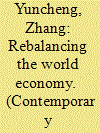

|
|
|
|
|
| Publication |
2014.
|
| Summary/Abstract |
China - US economic cooperation is at a critical stage, with both countries pushing their own economic restructuring in different ways. While the US has proposed a rebalancing strategy to promote its economic recovery, aiming to achieve a rebalancing not solely driven by consumption, China recognizes its need to achieve balanced economic growth and expending its domestics demand to substitute for a dependence on investment.
|
|
|
|
|
|
|
|
|
|
|
|
|
|
|
|
| 16 |
ID:
123212


|
|
|
|
|
|
|
|